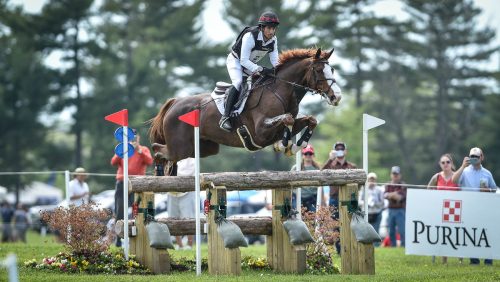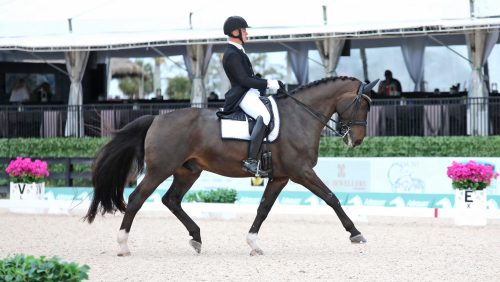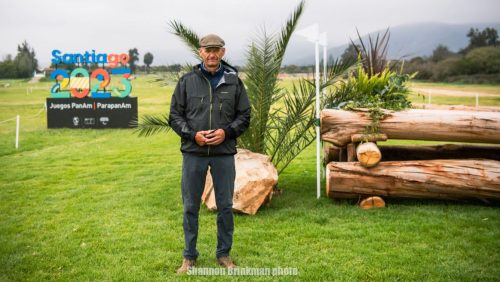Mary Hazzard has always known Magic Replica was special—and not only because he’s by her great homebred eventing stallion Mystic Replica.
These days, the 10-year-old gelding is the talk of any event he goes to because of his white spots, which appeared randomly and suddenly and are now magically disappearing again.
Born a plain bay, “Magic” had the breeding to become a talented eventer (his sire is by famed event sire Babamist, while his mother, June, was a Belgian-Thoroughbred cross), and he proved trainable and easygoing throughout his early years, but one day at age 6, he began sporting white spots.
“All of a sudden he started getting these spots and every day he would get a new one. They wouldn’t fade—it was just overnight in the morning, we’d have a new spot!” said Hazzard.
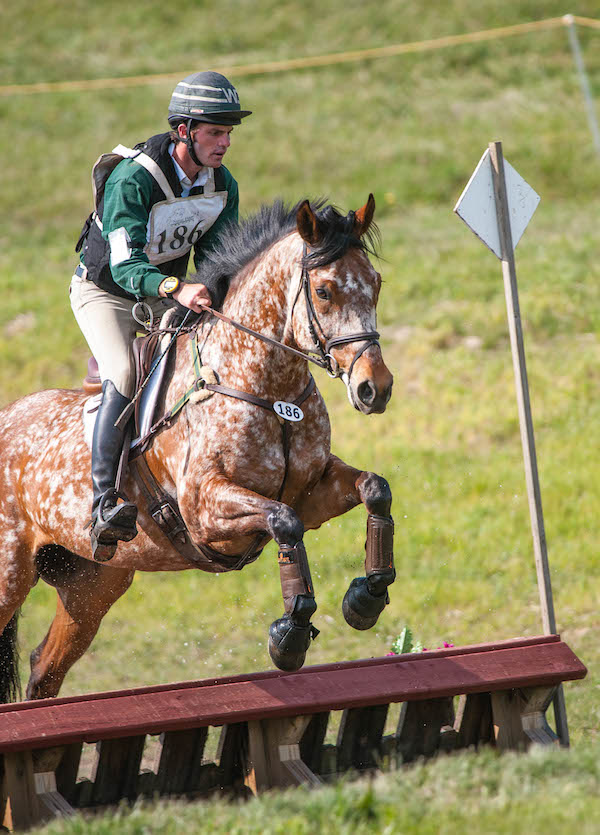
Magic Replica at his most spotted—eventing with Ryan Wood in 2012. Photo by Amy Dragoo
Hazzard had samples of his hair analyzed by every geneticist and vet she could find, but no one had a real answer or name for his condition.
“He’s had skin biopsies and the whole thing, and nobody has any reason or concrete information as to why he’s had this color switch,” she said.
The only other way Hazzard could explain his spots was that his sire was related to The Tetrarch, a famous gray Thoroughbred stallion with white spots from the early 20th century who seemed to pass down his coloring.
Hazzard broke and started Magic and sent him to upper level rider Ryan Wood, who lives near her Lanefield Farms in Unionville, Pa., when he was ready to move up the levels.
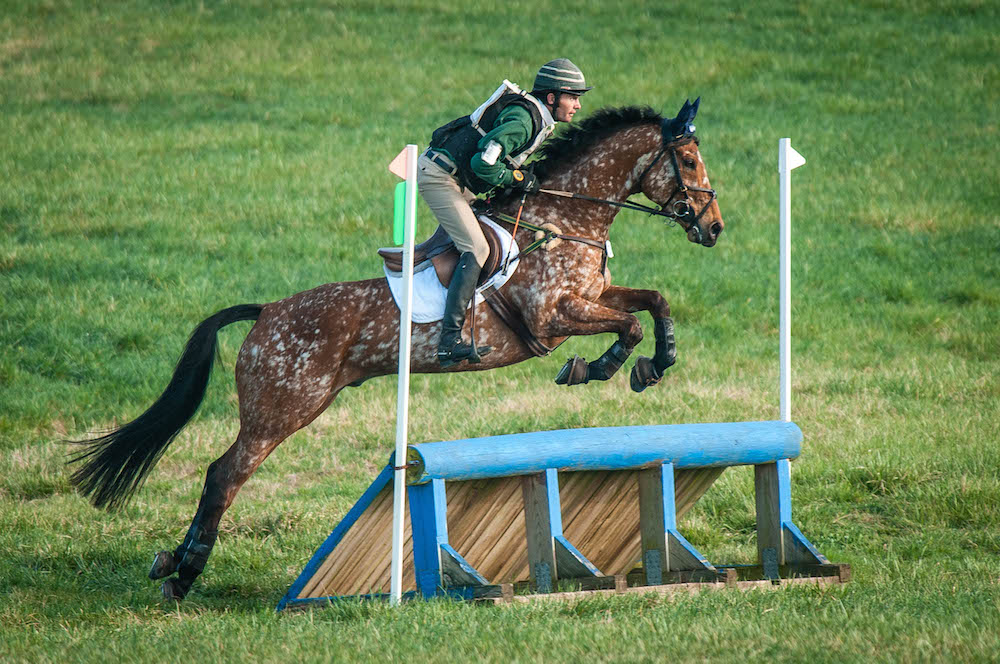
Magic Replica at preliminary level in 2013 with Ryan Wood. The spots had started to fade. Photo by Amy Dragoo
ADVERTISEMENT
“His personality is as unique as his color,” she said. “He’s like a Labrador Retriever. He’d get in your pocket and go with you if you asked. He’s extraordinarily athletic and very fast. He just loves to run and jump, that’s his favorite thing. The dressage isn’t his forte, but he can do it as well as anybody. They’re real people horses. With Babamist and Mystic Replica, you wouldn’t even know they were stallions. I competed them everywhere and you never heard them whinny or misbehave.”
Hazzard has heard it all from people who see Magic at shows, but most often, people think he’s an exotic warmblood or Appaloosa.
“Everybody had a theory he was a German Knabstrupper, but they’re white with brown spots, not bay with white spots,” she said. “Then everybody thought he was some kind of weird Appaloosa! He’s a big boned, big bodied horse.”
Wood competed Magic to the CCI* level, when he was at his most spotted. “Getting his FEI passport was a trip,” said Hazzard. “My veterinarian refused to do it because you had to draw all those spots. The people from New Bolton Center [Pa.] came and took 5,000 pictures and then did it from the pictures. It was pretty funny.”
Last year, Wood helped sell the gelding to young rider Hannah Sommer as a schoolmaster.
The New Hampshire-based 20-year-old was looking for a horse to gain confidence on as she started her eventing career. She purchased him in September, then after finishing her first year of community college, decided to become a working student for Wood.
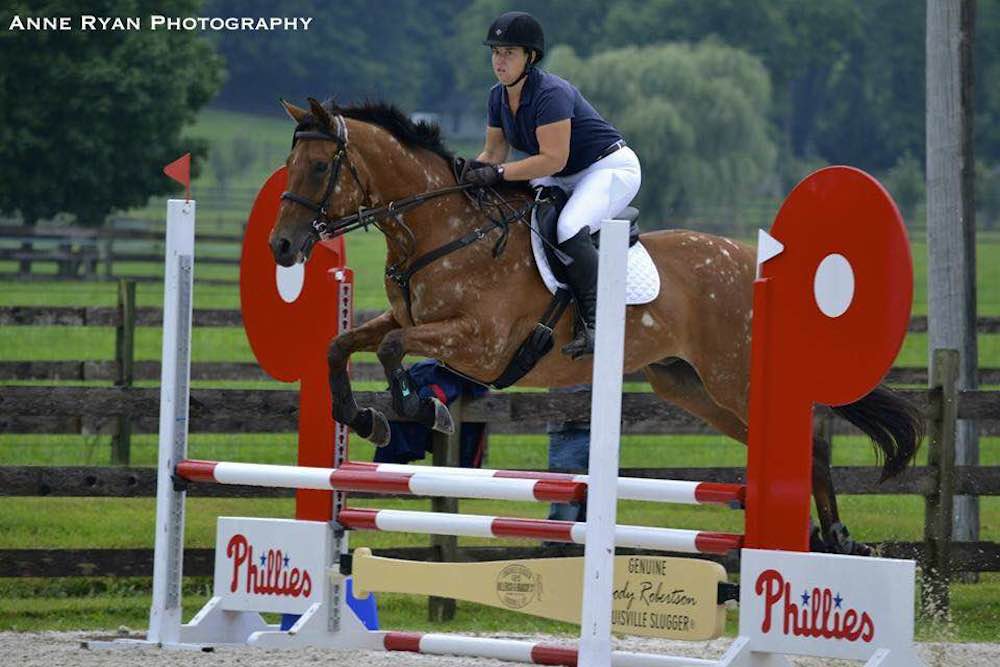
Magic Replica as he looks in the summer of 2015, showing with Hannah Sommer aboard and even less spots. Photo by Anne Ryan Photography
“I had a pretty bad fall off of [my old horse, a draft cross] that landed me in the hospital and that was the first time I ever went cross-country, so it’s cool that Magic brought me back into it and allowed me to gain the confidence on cross-country that I wasn’t able to have on my other horse,” she said.
The pair completed their first beginner novice in July at the Maryland Horse Trials but fans might not recognize Magic now as he’s started to lose his spots.
“I have pictures of him when we first tried him and he was way more spotted than he is now,” Sommer said. “When I first [took him out to a show], somebody was videoing me in the warm-up, which was weird. Most of the time, people will just look at him and ask what he is. It’s kind of cool, nobody really knows what he is.”
ADVERTISEMENT
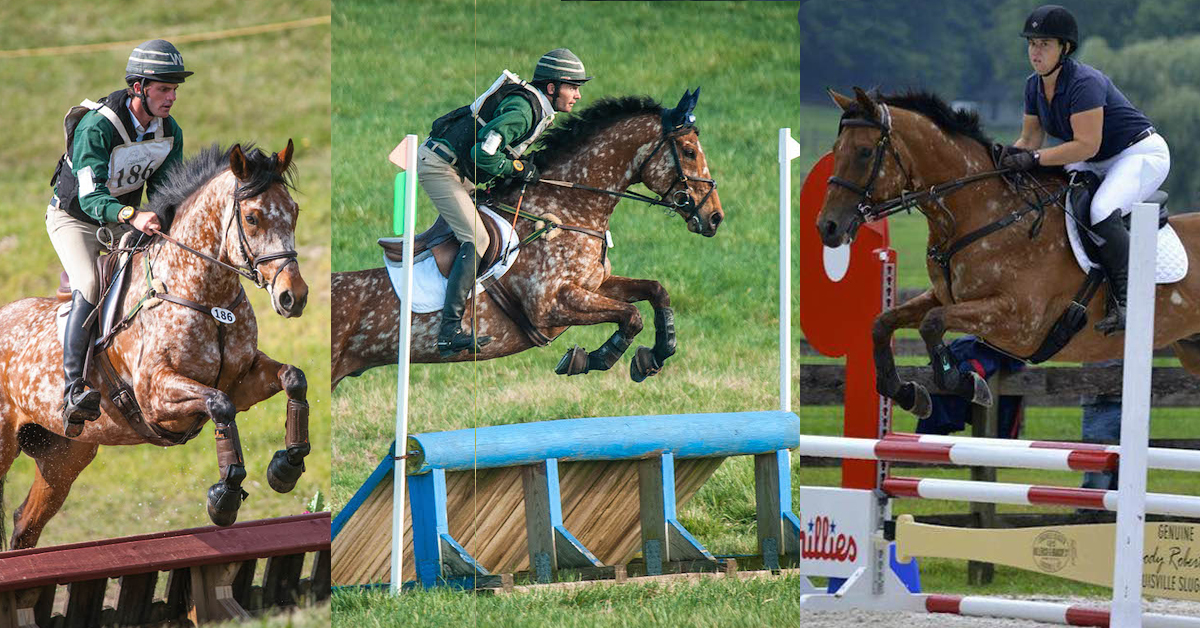
The progression of the spots…
Magic has turned into a great teacher for Sommer even though he was a bit more forward than she was used to when she first bought him.
“He’s very forward thinking. He’s cool because in order to ride him well, you have to be able to think ahead of him, and it’s really pushed me to be a responsible rider,” she said. “I bought him as a horse to move up on and a confidence booster for me and he’s been just wonderful at that.”
Hazzard is also happy that her homebred has found a loving home.
“All I wanted was for him to be happy and this little gal came along and it was like a match made in heaven,” she said. “It’s what you really want—to see the horses you’ve raised and trained go on and make other people happy and be happy themselves.”
|
Why The White? While Mary Hazzard has never been able to confirm the cause of Magic Replica’s spots, there are several theories for horses that display a similar coat. Some horses with white spots that appear after they’re born are believed to have had a fungal infection that turns the hair white, although the scarring from the infection is usually not deep enough to result in permanent loss of pigment. It sometimes takes years to recover, if at all. Another theory is a copper deficiency. There are reports of horses who developed spots, were given more copper in their diet, then lost the spots. Many Thoroughbreds also get Birdcatcher spots, named after a famed racehorse who had white spots. Other breeds such as Arabians, Saddlebreds, warmbloods and Quarter Horses are also known to develop the spots during life. |








